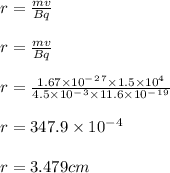
An antiproton is identical to a proton except it has the opposite charge, −e. To study antiprotons, they must be confined in an ultrahigh vacuum because they will annihilate−producing gamma rays−if they come into contact with the protons of ordinary matter. One way of confining antiprotons is to keep them in a magnetic field. Suppose that antiprotons are created with a speed of 1.5 × 10^4 m/s and then trapped in a 4.5 mT magnetic field. What minimum diameter must the vacuum chamber have to allow these antiprotons to circulate without touching the walls?Express your answer with the appropriate units. d =

Answers: 1
Another question on Physics

Physics, 22.06.2019 16:40
Beryl states that insulation with the smallest possible thermal conductivity is best to keep a house warm in winter, but worst for keeping a house cool in summer. sapphire insists the reverse is true: low thermal conductivity is good in the summer, but bad in the winter. which one, if either is correct? a. beryl, because low thermal conductivity results in low heat transfer. b. beryl, because low thermal conductivity results in high heat transfer. d. sapphire, because low thermal conductivity results in high heat transfer. e. neither, because low heat transfer is desirable both in summer and in winter.
Answers: 2

Physics, 22.06.2019 23:30
The photo above shows oil and vinegar in a pitcher. the top make a claim about about the density of the vinegar compared to the density of the oil summarize the evidence to support the claim and explain your reasoning
Answers: 3

Physics, 23.06.2019 06:10
Question 1(multiple choice worth 2 points) in order to be considered work, the components that must be present are • a force and a movement in the same direction as the force an action which causes movement and an opposite reaction an action which causes no movement or reaction a force and a movement in the opposite direction of the force
Answers: 1

Physics, 23.06.2019 07:00
I) a gas contained within a piston-cylinder assembly undergoes two processes, a and b, between the same end states, 1 and 2, where p1 = 10 bar, v1 = 0.1 m3 , u1 = 400 kj and p2 = 1 bar, v2 = 1.0 m3 , u2 = 200 kj: ' process a: process from 1 to 2 during which the pressure-volume relation is pv = constant. ' process b: constant-volume process from state 1 to a pressure of 2 bar, followed by a linear pressure-volume process to state 2. kinetic and potential energy effects can be ignored. for each of the processes a and b, a) sketch the process on a p-v diagram. b) evaluate the work, in kj. c) evaluate the heat transfer, in kj.(ans : qb,12 = -65.0 kj)
Answers: 3
You know the right answer?
An antiproton is identical to a proton except it has the opposite charge, −e. To study antiprotons...
Questions





Mathematics, 20.05.2021 02:20

Mathematics, 20.05.2021 02:20


Mathematics, 20.05.2021 02:20


Mathematics, 20.05.2021 02:20

Mathematics, 20.05.2021 02:20

Law, 20.05.2021 02:20

Mathematics, 20.05.2021 02:20




Mathematics, 20.05.2021 02:20


Social Studies, 20.05.2021 02:20

Arts, 20.05.2021 02:20




